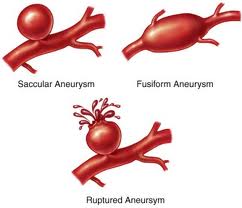Aneurysm definition and symptoms

What is Aneurysm and Definition
Aneurysm is a weakened and often distended (stretched) area in the wall of an ARTERY. Though an aneurysm may develop in any artery, the most common location is the descending or abdominal AORTA. An aneurysm is potentially life-threatening. The continual pressure of the BLOOD flowing through the artery pressures the weakened area, which can cause the layers of the artery’s wall to further split and separate, called a dissecting aneurysm, or to rupture. An aneurysm that ruptures in the BRAIN causes hemorrhagic STROKE, with mild to severe consequences depending on its location and size. Fewer than 5 percent of strokes are hemorrhagic.
Aneurysms sometimes accompany congenital malformations of the blood vessels, called ARTERIOVENOUS MALFORMATIONS (AVMs), in which the arteries and veins in a particular location, usually in the brain or brainstem, form an entangled mass. Aneurysms are also common in MARFAN’S SYNDROME, a genetic disorder that affects the musculoskeletal and cardiovascular systems. Most aneurysms, however, result from atherosclerotic deposits that damage and weaken the walls of the arteries. HYPERTENSION (high BLOOD PRESSURE), when present, exacerbates the situation by exerting further pressure against the weakened area of the artery.
A ruptured aneurysm is a life-threatening emergency that requires immediate medical attention. Loss of blood can be rapid and massive.
Symptoms of Aneurysm
Often an aneurysm shows no symptoms. The doctor may detect an aneurysm during a ROUTINE MEDICAL EXAMINATION or during testing or treatment for other medical conditions. Cerebral aneurysms may cause seizures, HEADACHE, or symptoms similar to stroke such as weakness on one side of the body and memory lapses or cognitive dysfunction. An abdominal or thoracic aortic aneurysm may cause PAIN (usually severe) in the area of the aneurysm. These symptoms are usually transient (come and go) though are crucial warning signs that the aneurysm is unstable. Sometimes the doctor can palpate an abdominal aneurysm, feeling its pulsations through the abdominal wall. COMPUTED TOMOGRAPHY (CT) SCAN or MAGNETIC RESONANCE IMAGING (MRI) can affirm the diagnosis. Surgery to repair the aneurysm, in which the surgeon either removes the weakened segment and sutures the healthy ends of the artery together or applies a synthetic patch over the area of weakness, is the only curative treatment. When doctors detect and repair aneurysms before they rupture, they seldom cause further health problems and require no special care after HEALING. It is important to treat the condition that may have caused the aneurysm, when possible, to prevent aneurysms from developing in other locations.
See also ATHEROSCLEROSIS; COGNITIVE FUNCTION AND DYSFUNCTION; CONGENITAL ANOMALY; CORONARY ARTERY DISEASE (CAD); GENETIC DISORDERS; LIFESTYLE AND CARDIOVASCULAR HEALTH; SEIZURE DISORDERS.
Open discussion on the topic Aneurysm definition and symptoms
Similar interests
- Casino Non Aams
- Nuovi Casino
- Casinos Not On Gamstop
- UK Casinos Not On Gamstop
- Casinos Not On Gamstop
- UK Casinos Not On Gamstop
- Casino Non Aams Italia
- Slot Sites Not On Gamstop
- Meilleur Casino En Ligne
- Non Gamstop Casino Sites UK
- Meilleur Casino En Ligne
- Casino En Ligne France
- Best Non Gamstop Casinos
- Casinos Not On Gamstop
- UK Casino Not On Gamstop
- Casinos Not Signed Up To Gamstop
- Best Slot Sites UK
- Non Gamstop Casino Sites UK
- Online Casinos Nederland
- Online Casinos Nederland
- Casinos Not On Gamstop
- Best New Uk Casinos Not On Gamstop
- Casino Non Aams
- Non Gamstop Casinos UK
- Migliori Siti Casino Non Aams
- Bitcoin Casinos
- Sites De Paris Sportifs Belgique
- Bookmaker Non Aams
- Casino En Ligne
- Casino Français Sans Kyc
- Casino Nouveau En Ligne